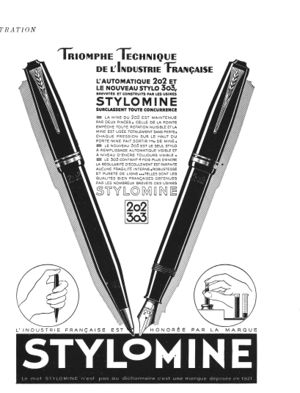Stylomine
Stylomine is one of the oldest French producers, which is highlighted in the fountain pen history for the unique filling system (which, by the shape of the sac, is called accordion filler) which distinguished his pens, that after the expiry of the relevant patent was adopted by many other French producers.
Although the produced models were few, the production company was still of high quality, and very interesting in the French market, in which the company was one of the most significant actors. The company has distinguished itself by technological innovation, having patent an hooded nib before the Parker 51 one, but like all historic French manufacturers could not withstand the impact of the advent of the ballpoint pen and disappeared from the market in the early 60s.
| Stylomine |
|---|
| Brand pages |
| Brand advertising |
| Brand photos |
| Instructions sheet |
| Patents |
History

An exact date for the founding of the company with the same name created by Yves E. Zuber it is not known[1] whose activities originate at the end of the first World War, with offices and factory in Paris on Rue Neuve des Boulet, 34-36 and in the Rue de Nice, 2 and later on Avenue Martin Moreau, 45 that was active on the market in the molding and assembly of metal parts, as bag hooks or clips and nibs for fountain pens.
The Stylomine brand was officially registered in 1921 with n. 199226, and was used by Yves E. Zuber for his pencils. The fountain pen production began only in 1925 with some safety models in black or red marbled black hard rubber. It was relevant also for the production of overlays in both rolled gold or precious metals. But in this period the product most characterizing the company's production is the mechanical pencil Autostyl, in which the mine is automatically replaced after exhaustion. The production of mechanical pencils will continue for all following years, with different names such as Stylomine Automatic and Stylomine 202.
But the fountain pen which made famous Stylomine is the 303 model, introduced in 1930 and equipped with a series of very peculiar technical solutions, as a large-capacity and very functional bulb filler system, very functional and high-capacity thanks to a breather tube ingeniously connected to the feeder (patent nº FR-712327), which allowed the full loading of the pen with only four or five strokes.
A questo modello venne aggiunto nel 1933 un particolarissimo gruppo pennino montato su una molla che veniva fatto rientrare con l'avvitamento del cappuccio grazie alla pressione di una punta interna (vedi brevetto nº FR-737930). Questo sistema, insieme al pennino rientrante, venne usato nel nuovo modello 303B, prodotto in tre versioni corrispondenti a tre diverse misure. Il caricamento era un perfezionamento del precedente sistema della 303 e venne usato anche per il modello 303C, senza pennino rientrante, che oltre alle tre versioni precedenti venne realizzato in celluloide e con una quarta dimensione, sufficientemente grande da farla denominare Mastodonte.
Ma l'invenzione più significativa della produzione dell'azienda, che ne costituisce un po' la caratteristica distintiva, è il rivoluzionario sistema di caricamento a fisarmonica, brevettato (nº FR-854177) nel 1938, Si tratta di una peculiare variante di caricamento a sfiatatoio che le consentiva una grandissima capacità di inchiostro, in cui il pompaggio veniva effettuato grazie ad un sacchetto per l'inchiostro con le pareti a fisarmonica, ed in cui il bulbo era sostituito da un pulsante sotto il fondello, costituito da una ampolla di vetro inserita a scorrere nell'estremità posteriore del corpo, che si poteva premere per effettuare il pompaggio, ed utilizzare anche per vedere l'inchiostro rimanente.
E' di particolare interesse poi lo sviluppo del modello 303D, dotato di pennino carenato, forse il primo mai prodotto, il relativo brevetto (nº FR-850525) infatti è del 1938 ed anticipa di vari mesi il corrispondente brevetto (nº US-2223541) della Parker che l'azienda sembra aver di nuovo battuto sul tempo in termini di innovazione, ma l'azienda aveva comunque brevettato penne a pennino coperto fin dal 1932 (nº FR-750689). In questo caso comunque non sono note date esatte per la comparsa del modello sul mercato, che in alcuni casi viene riportata come molto più tarda.[2]
Nel 1937 circa[3] venne lanciato il modello 303V (la data comunque è alquanto incerta), che adottava il caricamento a fisarmonica ed un nuovo stile svasato e l'uso di un corpo in materiale plastico (cosa che fa sospettare una apparizione più tarda).
Nel dopoguerra la produzione vide la diffusione della 303D a pennino coperto, affiancata da altri modelli come la Super 303 con pennino a punta rotonda. Venne mantenuto il caricamento a fisarmonica sostituendo il pulsante in vetro con uno in materiale plastico. Nel 1947 vennero introdotte le matite meccaniche Stylomine 404 e nel 1948 venne introdotta la penna a sfera Stylomine 707.
The company tried to respond to the crisis introduced by the advent of disposable spheres: the lever filler 505 model was introduced (now very rare), the company also joined to Météore, Paillard and Unic to produce the Pulsa Pen and formed a consortium with Bayard and Unic to create the BUC cartridge. It also introduced a cartridge model recovering the historical 303 name. But as with most other historic French manufacturers, the efforts were useless and the company ceased operations in the 60s.
Chronology
| Year | Event
External references
Notes
|
|---|